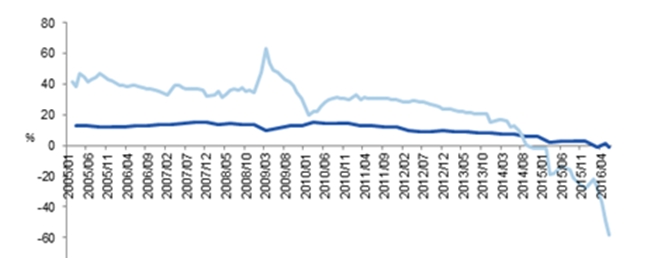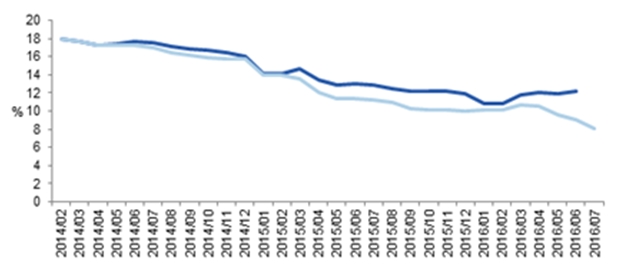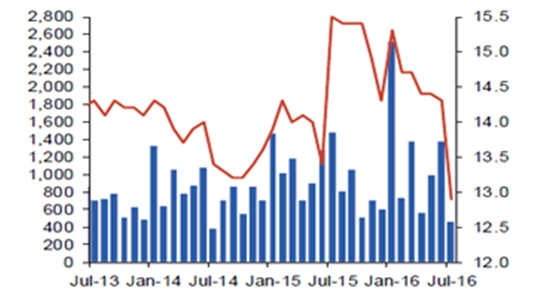Abnormal Sample
of Liaoning Province should not be calculated into the Evaluating on the
Continuous Falling Investment
Moreover, the
continuous fallback of the investment on the fixed asset varied with the
present policies of stabilizing growth. According to statistics, the investment
on the fixed asset obviously fell back in July, the year-on-year growth, which
turned to be the lowest level since 1999, declined from 9% to 8.1%. However,
according to investigation, currently, the data of fixed asset investment is
actually, or we can say to a great extent, distorted by the huge abnormal
reduction of Liaoning Province. For example, during H1 2016, total fixed-asset
investment declined by 58.1% YoY in Liaoning, whose growth rate of fixed-asset
investment had once been 60% since financial crisis and then plummeted since
2015. The reasons for this phenomenon on the one hand were the economic decline
and on the other hand related to the accuracy of statistical data. For example,
before 2006, the formation of the fixed-asset in Liaoning highly coincided with
the proportion of the fixed-asset investment to GDP, but during 2008 to 2014,
the difference between the two data gradually enlarged, and not until the year
after 2014, the gap between those two set of data narrowed. The abnormal
fluctuations of fixed-asset investment data disturbed analyzing on the actual
situation of investment.
Graph 4:
Investment on Fixed-Asset Plummeted in Liaoning Province since 2015

GDP of Liaoning Province Fixed-asset investment of Liaoning Province
However, the
growth of fixed-asset investment in other provinces rebounded backed by the
fiscal incentive of local governments this year. From the overall situation,
the abnormal data of Liaoning Province disturbed the overall trend of other
provinces, while after taking the data of Liaoning out, China’s domestic
fixed-asset investment can be relatively kept in a stabilized situation, from
this perspective of view, under the influence of the measure of stabilizing
growth, the present fixed-asset investment data tended to be stabilized.
Graph 5:
Relatively Stabilized Fixed-Asset Investment across the Nation (Except
Liaoning)

Fixed-Asset Investment except Liaoning Province Fixed-Asset Investment
Sluggish Credit and Loan Data should take the
Influence of Debt Replacement into Consideration
The credit and
loan data of July was also noteworthy. RMB loan increased by RMB463.6 billion,
RMB1.01 trillion less than that of the same period last year, among which the
loan of non-financial enterprises and group decreased by RMB2.6 billion, while
the loan of department increased by RMB457.5 billion. According to this data,
currently the real economy has hardly had any need in credit and loan, which
indicated a sign of sluggish economic activity. However, interpreting credit
and loan data should also take the influence of the debt replacement of the
government into consideration. In 2016, the debt replacement of the government
exceeded RMB5 trillion, which was RMB4,000 to 5,000 trillion in average each
month. The situation of credit and loan may not as negative as what the
negative growth has showed in July if we take the debt replacement of local
government into consideration.
Graph 6: Newly-Added Debt in July Neglected the Influence from Debt Replacement

Newly-Added Debt (billion) Year-on-Year Change (right axis)
Therefore, it is
believed that it’s necessary to integrate various data to analysis the current
economic data of China. For example, the data of industrial added value,
electric power output, and industrial enterprises profits were in directional
deviation when considering the actual situation of industrial production. And
according to the statistics, among the current industrial economic operation,
the positive factors have kept building up, the accumulation of new energy has
accelerated, and the high-end industry segments still in high speed increase,
therefore we can see that the actual industrial production was not as negative
as the continuously decreasing industrial added value. In the same way, the
data of the current investment and the credit and loan may be slightly positive
than the actual data if the abnormal data of Liaoning was eliminated and the
debt replacement factor was taken into consideration.
However, the risks
were also noteworthy. On the one hand, the economic structural problems
remained serious, the price of the real estate in major cities keep rising,
which formed a crowding-out effect on the real economy, moreover, under the
background of the Federal Reserve of the US raising the interest rate, boosted
the pressure on capital outflow and depreciation of exchange rate.
On the other hand,
the policy space is reducing. The year-on-year growth of the fiscal general
expenditure plummeted from 20% of June to 0.3% of July, growth of M2 decreased
from 11.8% of June to 10.2% of July, and the newly added RMB debt decreased by 68.7%
YoY, these three factors all together were important reasons for the declining
economic data.
In terms of the
monetary policy, in China, there are risks from the real estate market and
financial market, while overseas, with the expectation that the Federal Reserve
raising the interest rate, RMB depreciating, and the capital outflow and the
reality that the monetary policy was not as easy as that of the first half
year, the central bank would not reduce the interest rate and deposit reserve
ratio. In terms of fiscal policy, as there has already faced deficit during the
first half year, the space of the second half year would be limited, which we
can forebode from the 0.3% of the year-on-year growth in general fiscal
expenditure and 7.4% YoY decrease of expenditures incurred directly by the
central government in July.
*The
article is edited and translated by CCM. The original one comes from Laohucaijing.com.
About CCM:
CCM is the leading market intelligence
provider for China’s agriculture, chemicals, food & ingredients and life
science markets. Founded in 2001, CCM offers a range of data and content solutions, from price
and trade data to industry newsletters and customized market research reports. Our clients include Monsanto, DuPont, Shell, Bayer, and Syngenta. CCM is a
brand of Kcomber Inc.
For
more information about CCM, please visit www.cnchemicals.com or
get in touch with us directly by emailing econtact@cnchemicals.com or
calling +86-20-37616606.